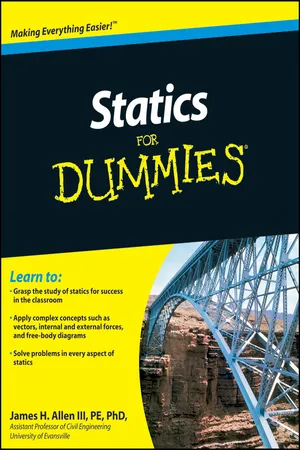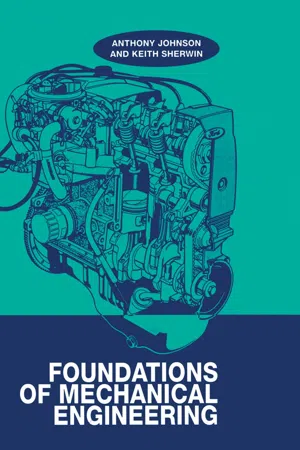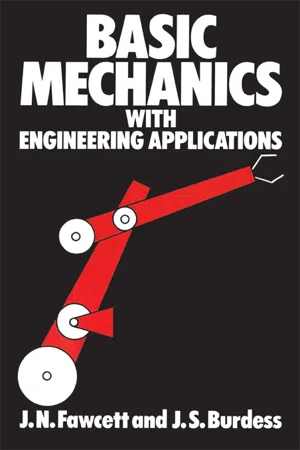Mathematics
Statics and Dynamics
Statics and dynamics are two branches of mechanics that deal with the study of objects at rest and in motion, respectively. Statics focuses on the equilibrium of forces acting on stationary objects, while dynamics examines the causes of motion and the effects of forces on objects in motion. These concepts are fundamental in understanding the behavior of physical systems.
Written by Perlego with AI-assistance
Related key terms
7 Key excerpts on "Statics and Dynamics"
- eBook - ePub
- James H. Allen(Author)
- 2010(Publication Date)
- For Dummies(Publisher)
which isn’t the study of how you should move across a shag carpet in order to apply a jolt of electricity to your younger siblings or how to implement the latest hygiene techniques to avoid those dreadful bad hair days. In this book, I definestatics as the mechanical study of the behavior of physical objects that remain stationary under applied loads (which I discuss later in this chapter). The behavior of the floor beams in your house as you stand in the middle of your living room is an example of a static application.The area of dynamics, on the other hand, is the study of objects in motion. So as you walk down the hall, your behavior and its effect on your house becomes a dynamic application. The result of a car driving down a bumpy road, the flow of water through a creek, and the motion of those shiny little metallic balls that hang from strings and haunt/hypnotize you with their “clack, clack, clack” as they bounce off each other are all examples of dynamic behavior.Finally, you come to mechanics of materials (sometimes referred to as strength of materials ), which is yet another branch of mechanics that focuses on the behavior of objects in response to loads. This area of mechanics builds on concepts from both dynamics and statics.Putting Vectors to WorkOne of the most basic tools to include in your basket of statics tricks is the knowledge of vectors, which I discuss in detail in Part II of this book. Think of vectors as being one of the major staples, such as rice or potatoes, of your statics kitchen. Statics forms the foundation for a complete meal of engineering design. Vectors come in all shapes and forms, and you can use them for a wide variety of purposes, which I introduce you to in Chapters 4 and 5.Peeking at a few vector typesBut the vector discussion doesn’t end there. I also show you several different ways to mathematically work with vectors, including building the foundation for a vector’s equation (see Chapters 6, 7, and 8).One of the first vectors you need to get familiar with is the position vector,which basically tells you how to get from one point to another. These vectors are very handy for giving directions, measuring distances, and creating other vectors; you can read about them in Chapter 5. - eBook - ePub
- A. D. Johnson(Author)
- 2017(Publication Date)
- Routledge(Publisher)
Statics 44.1 AIMS
- To introduce forces and their application.
- To describe the types of force which may be encountered.
- To explain how forces and force systems may be analysed using vectors.
- To introduce the concept of equilibrium.
- To show how the concept of equilibrium can be used to analyse force systems containing two or more forces.
- To explain how forces acting on bodies or systems create moments and couples.
4.2 Statics
Statics is the analysis of stationary objects under the influence of forces of various types. From Newton’s first law of motion a body can remain stationary only if there is no force acting on the body. Alternatively, if there are several forces which balance each other, the body is in equilibrium and remains stationary. It is necessary to define the types of forces which may be encountered and examine the ways in which they may be analysed.4.2.1 Applied forces
Applied forces are applied from an external source, such as when a block is suspended by a rope. The upward force in the rope is the applied force on the block, as shown in Figure 4.1(a) . If the applied force due to the rope did not exist, the block would simply fall under the action of gravity.4.2.2 Reactive forces
Newton’s third law says that for every applied force there is a reactive force present. In Figure 4.1(b) the reactive force is the force induced in the rope by the weight of the block. Applied forces and reactive forces always act in pairs. One cannot exist without the other. They always act along the same line and in opposite directions.Fig. 4.1 Suspended block showing (a) external forces, (b) reactive forces.4.2.3 Internal forces
Internal forces are the equal and opposite reactions to the externally applied loads. In Figure 4.2(a) the external forces are those which are applied by the weight of the trap-door to the cable and by the bracket to the cable. The internal forces lie within the cable and are the same magnitude as the external forces but act in the opposite direction, as shown in the free-body diagram in Figure 4.2(b) - eBook - ePub
- J. Jones, J. Burdess, J.N. Fawcett(Authors)
- 2012(Publication Date)
- Routledge(Publisher)
3StaticsBasic Theory3.1 IntroductionThe study of the special case of Newton’s Second Law in which the acceleration of the particle is zero is referred to as Statics. In these circumstances the resultant force acting on the particle must be zero so that, from eqn (2.1),Usually statics is concerned with systems which are at rest, although the results do apply to systems which are moving with constant velocity. (Remember that velocity is a vector quantity and for it to remain constant neither its direction nor its magnitude must change.)We will first consider the case of a particle, to which Newton’s Laws apply directly, and then consider the statics of rigid bodies.3.2 Equilibrium of a particle in a planeConsider a particle P in the XY plane of Fig. 3.1 with forces F1 … Fi… Fnapplied to it as shown. For the particle to be in a state of equilibrium, i.e. to have zero acceleration, eqn (3.1) givesFIG . 3.1Each of the forces FHence eqn (3.2) may be rewritten in component form asimay be expressed in components along OX and OY asIt has been shown in Chapter 1 that a particle moving in a plane has two degrees of freedom. Equations (3.4) show that the motion of the particle along the two co-ordinate directions corresponding to these two degrees of freedom is suppressed. Its equilibrium is therefore defined by two equations, one corresponding to each of the degrees of freedom.If a particle P is in equilibrium under the action of the four forces shown in Fig. 3.2(a) , the resultant of these forces must be zero, i.e.FIG . 3.2These forces can be added together using the rules of vector addition given in Chapter 1 (p. 2). The polygon of Fig. 3.2(b) - eBook - ePub
- Peter F. Drucker(Author)
- 2017(Publication Date)
- Routledge(Publisher)
VI Statics and Dynamics * S OME Q UERIES R EGARDING THE M ECHANICAL A NALOGY IN E CONOMICS T HE frequency and familiarity with which the terms static and dynamic are used in economic literature contrast somewhat strangely with the paucity of discussion of their meaning, and the comparative abundance of argumentation regarding the necessity for such a distinction throws into even stronger light the lack of effort at clear definition. Marshall’s usage is typical; he constantly uses the terms static and dynamic, and kindred expressions like caeteris paribus and “unchanging general conditions of economic life,” and repeatedly insists on the importance of clearness in regard to them; but he nowhere offers a complete list of the static data, or “other things,” or attempts a clear statement of the principles at issue. There are exceptions to this procedure of course; notably the work of J. B. Clark, Schumpeter, and the mathematical school of Walras and his successors. It is not the intention in this paper to go through die literature, or selected specimens of it, and give a detailed criticism. Neither is there any serious pretence of supplying in a positive, constructive way all that seems to be wanting. The aim is merely to raise certain questions, without attempting to give the final answers. The terms Statics and Dynamics are of course borrowed from theoretical mechanics. Most of the writers who have used them were no doubt aware that the analogy of economic theory to mechanics is subject to limitations, like all analogies. Schumpeter, indeed, explicitly remarks (Wirtschaftliche Entwicklung, p. 75) that there is no connection with mechanics, which we suggest is as far from the truth as an assumption of complete parallelism. There is a real and important relation, or the words would not have been taken over, and the constant use of the concepts of friction and inertia is additional proof that the analogy of mechanics exerts a large influence on the thinking of economists - eBook - ePub
A Dynamic Approach to Economic Theory
The Yale Lectures of Ragnar Frisch
- Ragnar Frisch, Olav Bjerkholt, Duo Qin(Authors)
- 2013(Publication Date)
- Routledge(Publisher)
force . In kinematics this notion does not occur. In the following I shall not go into further consideration of the distinction between kinematics and dynamics (in the restricted sense). That, which in the following will be called dynamics (within economics), is the entire non-statical part of the analysis. In those parts of economic theory where it is possible to define a notion of force, it will also be possible to subdivide this non-statistical part of the theory into a kinematics part and a part which is, in a more restricted sense, dynamic.When we adopt the dynamic point of view – the comparison between one point of time and the following – we need some new notions which do not occur in the static analysis. The most important of these notions is the notion of rate of change with respect to time, that is, velocity with respect to time. More generally, one could speak of the reaction velocity of the system (or of the process) for certain inciting agents. The notion of velocity with respect to time can be illustrated graphically in the following way. Let us consider a train in movement. We draw a time series showing how the distance covered varies as a function of time: After one minute the distance covered is one mile, after two minutes it is 2.3 miles, and so forth. The slope6 of this curve at a given moment of time represents the ratio between a small increment in distance and the corresponding small increment in time, and this ratio is just the velocity with respect to time. It is the velocity with which the distance grows per minute (in the particular moment of time considered).The slope of such a time series may vary from one moment of time to another. We can represent this variation by drawing a new time series whose ordinate represents the rate of change for the first curve. For this new curve we can again (in every moment of time) compute the rate of change. This quantity (i.e. the rate of change of the rate of change) is called the acceleration - eBook - ePub
- Godfrey Onwubolu(Author)
- 2014(Publication Date)
- ICP(Publisher)
PART 1
Statics
Passage contains an image
Chapter 1
Introduction
Objectives: When you complete this chapter you will have:• Understanding of the different areas of applied mechanics. • Understanding of how SolidWorks can be applied to the different areas of applied mechanics.Applied Mechanics
As a scientific discipline, applied mechanics derives many of its principles and methods from the physical sciences (in particular, mechanics and classical mechanics), from mathematics and, increasingly, from computer science. As such, applied mechanics shares similar methods, theories, and topics with applied physics, applied mathematics, and computer science.Applied mechanics, as its name suggests, bridges the gap between physical theory and its application to technology. As such, applied mechanics is used in many fields of engineering, especially mechanical engineering. In this context, it is commonly referred to as engineering mechanics. Much of modern engineering mechanics is based on Isaac Newton’s laws of motion while the modern practice of their application can be traced back to Stephen Timoshenko, who is said to be the father of modern engineering mechanics.Applied mechanics in engineering
Typically, engineering mechanics is used to analyze and predict the acceleration and deformation (both elastic and plastic) of objects under known forces (also called loads) or stresses.When treated as an area of study within a larger engineering curriculum, engineering mechanics can be subdivided into:•Statics, the study of non-moving bodies under known loads.•Dynamics, the study of how forces affect moving bodies.•Mechanics of materials or strength of materials, the study of how different materials deform under various types of stress.•Deformation mechanics, the study of deformations typically in the elastic range.•Fluid mechanics - eBook - ePub
Preface to Social Economics
Economic Theory and Social Problems
- John Clark(Author)
- 2017(Publication Date)
- Routledge(Publisher)
VI The Relation Between Statics and Dynamics * Maurice Clark John1 Forecast of the Argument
THE task which forms the subject of this essay is essentially that of one who wishes to carry forward the work of his greatest teacher from the point at which that teacher left it. From this standpoint the main problem is how to proceed from static to dynamic economics. This problem will be viewed in the light of the fact that we possess a substantially complete static economics, while dynamics is in its infancy; of the further fact that statics is essentially provisional, a stepping-stone to dynamics, simplifying the problem by attacking first those features which do not involve change; and of the final fact that dynamics must restore realism by putting in everything that statics leaves out, so far as possible within the limits of human understanding.In this view of the purpose of statics and the scope of dynamics, the writer is directly following his father’s teachings on these matters. Naturally, in attempting to do justice to such an all-inclusive view of dynamics, it becomes necessary to utilize material derived from a multitude of sources, often widely divergent in character.As to method of procedure, the question arises whether we should start with static conclusions, add dynamic elements one at a time and make allowances for the resulting “disturbances” of static equilibrium, or whether we should follow a more fundamental method, going back to the premises and replacing static by dynamic assumptions and then building upon them. This will, of course, require inductive methods in establishing the premises of a dynamic study; after which the problem remains whether, having got such premises, we shall be in a position to proceed deductively, or whether more induction will be necessary in reaching the conclusions of the dynamic study. The further question arises, to what extent it will be found that dynamics differs from statics not merely in its conclusions but also in its problems.
Learn about this page
Index pages curate the most relevant extracts from our library of academic textbooks. They’ve been created using an in-house natural language model (NLM), each adding context and meaning to key research topics.






